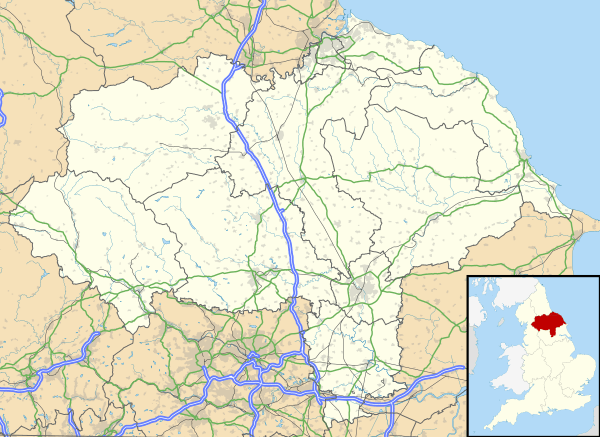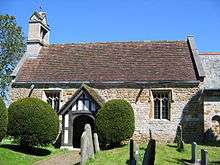Foston, North Yorkshire
Foston is a small village and civil parish in the Ryedale district of North Yorkshire, England. The population of the civil parish as of the 2011 census was 263.[1] Details are included in the civil parish of Whitwell-on-the-Hill. It is situated close to the A64 road and is approximately 9 miles (14 km) north-east from York.
| Foston | |
|---|---|
 Looking north-east to Foston | |
 Foston Location within North Yorkshire | |
| Population | 263 |
| OS grid reference | SE698651 |
| • London | 180 mi (290 km) SSE |
| Civil parish |
|
| District | |
| Shire county | |
| Region | |
| Country | England |
| Sovereign state | United Kingdom |
| Post town | YORK |
| Postcode district | YO60 |
| Police | North Yorkshire |
| Fire | North Yorkshire |
| Ambulance | Yorkshire |
| UK Parliament |
|
History
The village is mentioned in the Domesday Book as "Fostun" in the Bulford hundred. At the time it was the possession of Earl Morcar, but had passed to Count Alan of Brittany by 1086. It was also recorded that there was a church here.[2] The etymology of the name is from Old Scandinavian meaning "Fotr's settlement".[3]
Governance
The village lies within the Thirsk and Malton UK Parliament constituency. It also lies within the Hovingham & Sheriff Hutton electoral division of North Yorkshire County Council and the Ryedale South West ward of Ryedale District Council.[4]
Geography
According to the 1881 UK Census the population was 99.[5] Local council estimates the current population as 50.[6] The nearest settlements are Thornton-le-Clay 0.7 miles (1.1 km) to the west; Bulmer, North Yorkshire 1.5 miles (2.4 km) to the north; Whitwell-on-the-Hill 1.7 miles (2.7 km) to the east and Barton Hill, North Yorkshire 1 mile (1.6 km) to the south-east. To the east of the village is Spittal Beck, a tributary of the River Derwent.[4]
The village is the site of a Scheduled monument, this being a medieval settlement and moated monastic grange.[3][7] In addition to the church, the Rectory and Foston Hall are also Grade II listed buildings.[8]
Religion

The presence of a church in the village was recorded at the time of the Norman invasion, but the present building, dedicated to All Saints, dates from the 12th century with subsequent renovations.[5] It is a Grade II listed building.[9]
Notable residents
The noted English writer and Anglican cleric, Sydney Smith, was rector of the parish from 1806 until 1829 and resident in the village from 1809.[10]
References
- UK Census (2011). "Local Area Report – Foston Parish (1170211182)". Nomis. Office for National Statistics. Retrieved 17 March 2018.
- Foston in the Domesday Book. Retrieved 22 December 2012.
- "Etymology" (PDF). Archived from the original (PDF) on 3 December 2013. Retrieved 22 December 2012.
- Ordnance Survey Open Viewer"Archived copy". Archived from the original on 5 October 2012. Retrieved 14 October 2012.CS1 maint: archived copy as title (link) CS1 maint: BOT: original-url status unknown (link)
- Bulmer's Topography, History and Directory (Private and Commercial) of North Yorkshire 1890. S&N Publishing. 1890. p. 706. ISBN 1-86150-299-0.
- "Population" (PDF). Archived from the original (PDF) on 29 August 2012. Retrieved 22 December 2012.
- "Foston medieval settlement and moated monastic grange, Foston - Ryedale". Historic England. Retrieved 17 January 2018.
- "Listed Buildings". Retrieved 22 December 2012.
- "Church Listing". Retrieved 22 December 2012.
- Alan Bell, Sydney Smith: A Biography (Oxford: Oxford UP, 1980), pp. 72, 84–147.
External links
![]()